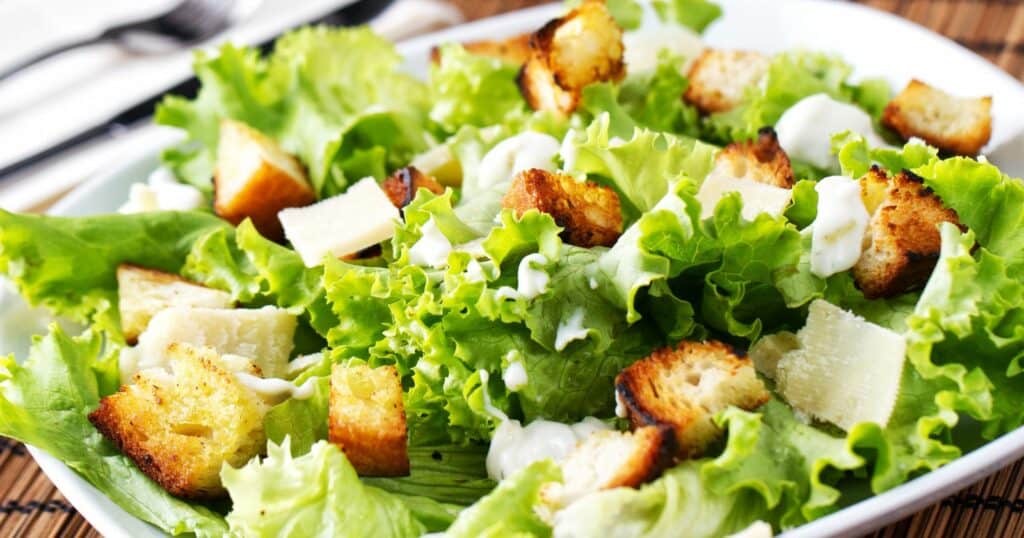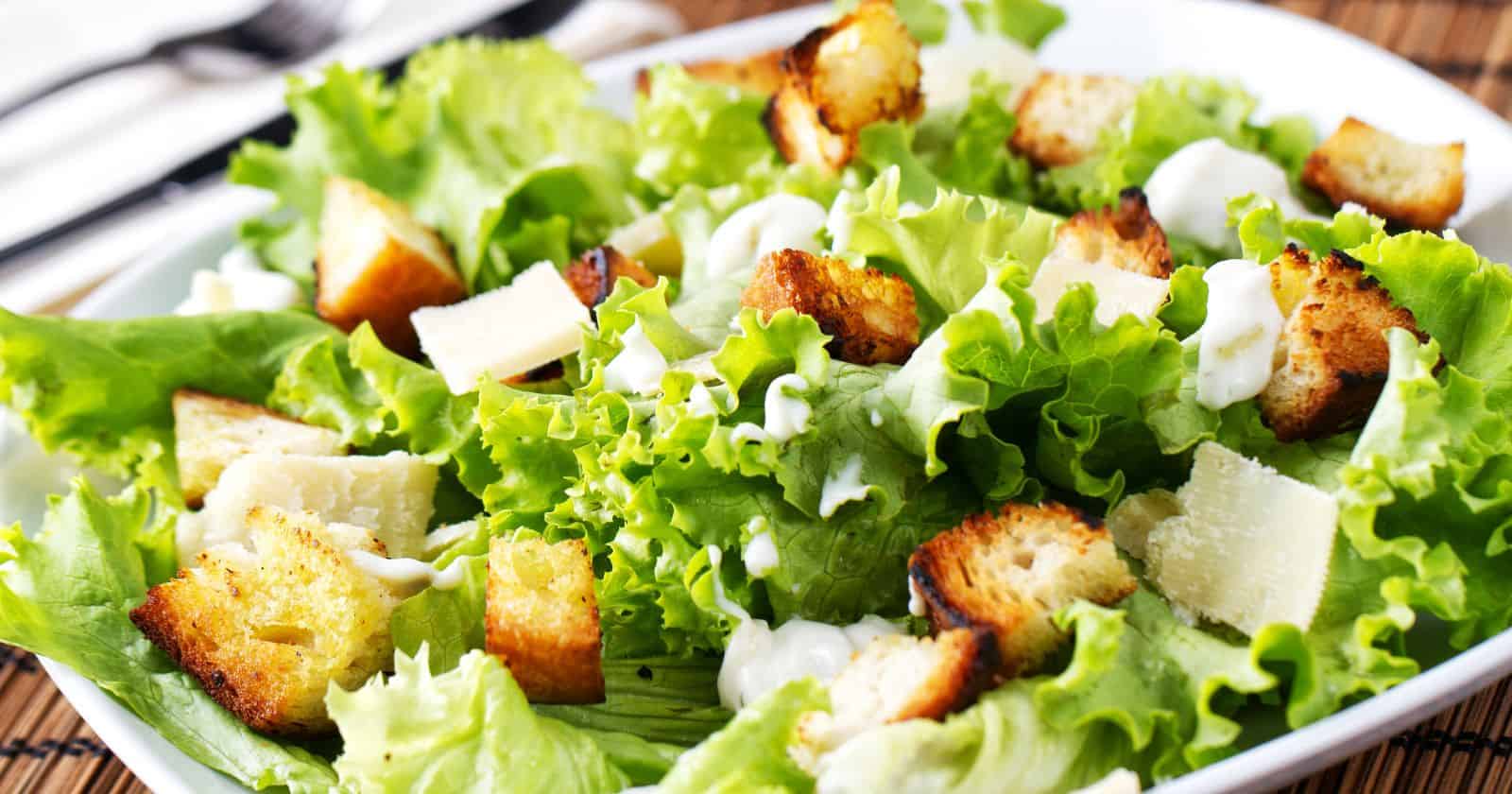Caesar salad is a cherished salad for good reason—its savory dressings and crisp romaine make it irresistible. But sometimes you bite into a Caesar salad expecting the usual tangy flavors only to be met with an unexpected fiery kick.
So is Caesar salad really supposed to be spicy? Or have creative chefs started tweaking the recipe? Let’s get to the bottom of this tasty mystery.
While spicy Caesar salads have become commonplace, the original recipe remains smooth and mild. But with customization, you can enjoy this salad however you like it best.
In this article, we’ll uncover:
- The origins of the classic Caesar salad recipe – Invented by Caesar Cardini in 1924, it traditionally contained no spicy ingredients.
- How spicy renditions likely came about – Chefs adding their own spins, confusion with other spicy salads, and regional taste preferences probably sparked the spicy trend.
- Tips for adding or reducing
spice to suit your tastes – Adjust ingredients, choose lettuces wisely, and communicate preferences to achieve your idealspice level. - When to expect a spicy Caesar salad or not – Check menus, ask servers, or customize your homemade dressings based on diner preferences.
Let us know if you have any other Caesar salad mysteries you’d like us to demystify!
The Birth of Caesar Salad: A Creamy, Tangy Original
To understand if Caesar salads are meant to be spicy, it helps to look at the original recipe and its humble beginnings.
Created in a Pinch But an Instant Hit
The Caesar salad was invented in 1924 by Italian immigrant Caesar Cardini. He owned restaurants in Tijuana, Mexico, and San Diego, California.
On 4th of July weekend, Cardini created the salad due to a shortage of ingredients. He combined romaine lettuce, olive oil, croutons, Parmesan cheese, boiled eggs, and Worcestershire sauce.
Despite the sparse pantry, the tangy salad was a huge hit. It became popular in Hollywood circles then spread across the US.
Traditionally More Creamy Than Spicy
Cardini’s original Caesar dressing contained:
- Olive oil and lemon juice for tanginess
- Egg yolks for richness
- Salt and pepper for seasoning
- Parmesan for nutty, salty flavor
- Anchovies and garlic for savoriness, without heat
- Worcestershire sauce for umami depth
So while zesty and flavorful, spicy ingredients like peppers were notably absent in Cardini’s creation.
When Did Spicy Caesar Salads Come About?

If the original Caesar salad wasn’t spicy, how did hot and tangy versions come to be? There are a few theories.
Chefs Adding Their Unique Twist
Creative chefs often can’t resist putting their personal spin on classics. Some may have introduced spicy ingredients to differentiate their Caesar salads.
Small tweaks like spicy mustard or hot sauce could give their salad a signature flair. Over time, patrons may have come to expect and enjoy the added heat.
Confusing Other Spicy Salads
Dishes like the Mexican salad or Southwest salad also use romaine lettuce. Their spicy ingredients like jalapeños and chili powder may have blurred lines between salad styles.
Some cooks may have unconsciously melded flavors if they were more familiar with these spicy renditions.
Playing to Local Tastes
Restaurants may add heat to appeal to local preferences. For example, cayenne and Tabasco are popular in New Orleans, Louisiana cooking. So Caesar salads there may reflect those regional
In Mexico, chilies and hot sauces are common. Mexican chefs may amp up Caesar’s flavors in line with local appetites.
So the spicy Caesar salad was likely not the brainchild of one innovator but an organic evolution.
Spicy vs. Non-Spicy Caesar Dressings
If you’re hoping for either a mild or spicy Caesar salad, look for these key ingredients that determine the heat level:
Cool and Classic Flavors
Traditional Caesar dressings stick to Cardini’s blueprint, including:
- Lemon juice
- Olive oil
- Egg yolks
- Dijon mustard
- Garlic
- Parmesan
- Worcestershire
Together they offer a cool, creamy and tangy flavor profile without much bite.
Heat-Packed Alternatives
Spicy Caesar dressings add zing using:
- Hot sauce or chili paste for intense heat
- Horseradish for aggressive
spice - Cajun seasoning with cayenne pepper
- Tabasco or other hot vinegars
- Jalapeño for milder kick
- Chipotle pepper for smokiness
So inspect the ingredients to see if there are any giveaways that
Achieving the Ideal Caesar Salad Balance
Of course, the question remains—should you stay true to Caesar’s original recipe or give in to spicy cravings? Here are some tips for getting the ideal Caesar salad flavor.
Taste the Dressing Before Adding
Make the dressing separately first. This allows you to adjust ingredients until you achieve the perfect tangy, creamy balance for your tastes.
Add small amounts of spicy ingredients like horseradish. It’s easy to
Pair Strong Lettuces with Strong Dressings
Hearty romaine can stand up to thick creamy dressings. But delicate greens like baby spinach will wilt under heavy, spicy dressings.
For mild salads, stick to light lemon juice- or vinegar-based dressings. They won’t overpower the greens.
Communicate Spice Preferences
When dining out, don’t assume the kitchen knows your tolerance. Ask if the Caesar dressing is spicy or mild.
If sharing the salad, agree on heat level. Adjust to accommodate those who can’t handle the burn.
Make It Your Way
Don’t be afraid to customize when serving the salad at home. Make two dressings—one mild, one spicy. Let guests mix and match.
Add spicy garnishes like croutons tossed in cayenne or chili flakes on the side. Then people can sprinkle on just as much fire as they want.
Should You Expect Spice In Your Caesar Salad?
After investigating Caesar’s history and modern twists, what’s the final verdict? Here are some tips on when to anticipate
- At authentic Italian restaurants, expect a traditional creamy dressing.
- Mexican restaurants may serve a Latin-inspired spicy dressing.
- Check the menu for any dressing descriptions suggesting heat.
- Ask servers about
spice level if concerned. - For homemade, adjust the dressing as desired.
- When sharing salads, warn guests about spicy additions!
So while spicy Caesar salads have become commonplace, the original recipe remains smooth and mild. But with customization, you can enjoy this salad however you like it best. Just remember, when in doubt, ask before you chomp down!
Let us know if you have any other Caesar salad mysteries you’d like us to demystify!





